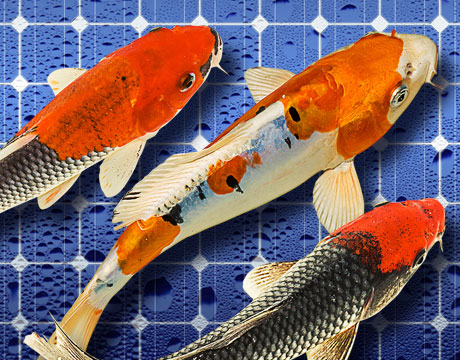Solar-Powered Aeration Boosts Developing World
Solar-Powered Aeration Boosts Developing World


A low-cost solar fish pond aerator could boost yields in most of the world’s aquaculture operations. Most artificial ponds worldwide are on family farms and other small-scale operations in developing countries. There, traditional aerators that require electricity can be costly and impractical.
The new passive device, created by a research team at the University of Toronto in Ontario, mixes pond water using heat from the sun. Its design sets it apart from traditional aerators as it requires no electricity, has no moving parts, and can be manufactured and maintained locally from readily available parts.
“What happens in these ponds is you end up with lots of dissolved oxygen in the top layer of the pond, but sunlight doesn’t penetrate deep enough to get oxygen into the rest of the pond. Our device circulates those layers,” said Amy Bilton, the principal investigator at the University of Toronto’s Water and Energy Research Lab, who is leading the work.
The problem with artificial fish ponds is that the fish die off if the water’s oxygen levels are too low. Fish can even get sick if there is too much oxygen. The ponds have natural oxygen generators in the form of phytoplankton at the water’s surface. These photosynthetic plants produce oxygen that dissolves in the water around them.
But in the still fish ponds, no currents mix the upper and lower layers of water. That sets up a thin band of safe water for the fish and a fragile environment for their survival. The water near the top of the pond can become supersaturated with oxygen so that it releases the gas into the atmosphere. That high concentration can be toxic to the fish, while deeper down, oxygen levels are too low for their survival.
The “Solar Updraft Aeration” system, as the new aerator is called, sets up a convection current. As the sun strikes a plate on the water’s surface, the device channels its energy downward to heat the walls of a vertical metal tube and a flared base on the bottom of the pond. The water under the base and inside the tube becomes warm and expands, forcing it upward through the tube and out holes in the tube just under the pond’s surface.
Prototypes for the device have entered field tests in partnership with researchers at BRAC University in Bangladesh. With funding from USAID, the researchers are building at least 80 aerators. Studies so far suggest the devices could finally put aeration in reach for impoverished farmers. That could translate into more fish.
Modeled simulations suggest that performance is surprisingly good. Aerators built with a vertical tube height of 0.5–1 meter, and a base flare length of 0.8–1.2 meters, could lift more than 1,500 liters of water per hour.
Real-world measurements of a pond that is two meters deep found that the bottom layer maintains an oxygen level of 2–3 milligrams per liter, while the topmost layer fluctuates between 4 mg/lat night, when the phytoplankton are not producing oxygen, up to 12 mg/lduring the day.
Laboratory models based on those measurements suggest that the new aerator can raise dissolved oxygen in the lowest layer so that it fluctuates between 6 mg/l at night to nearly 14 mg/lduring the day. If that is borne out in the real world, it may mean that aerators can mix the water sufficiently to create top-layer conditions throughout the entire depth of the pond.
“We’re always looking at how to do things better,” Bilton said. “Since the pilot, we’ve made some substantial changes to them. They keep getting more efficient and effective.” Rob Goodier is the editor of Engineering for Change.
What happens in these ponds is you end up with lots of dissolved oxygen in the top layer of the pond, but sunlight doesn’t penetrate deep enough. Our device circulates those layers. Prof. Amy Bilton, University of Toronto’s Water and Energy Research Lab




